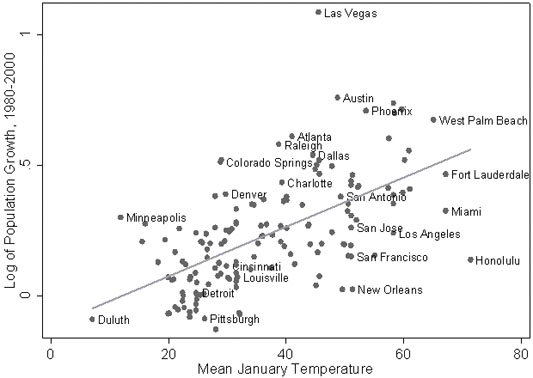It was close to 60 degrees in Manhattan yesterday which reminded me I neglected to post Ed Glaeser’s fascinating commentary in the Economix Blog of the New York Times called Revenge of the Rust Belt.
It also brought to mind a Steven Wright favorite of mine:
>It doesn’t matter what temperature the room is, it’s always room temperature.
But I digress
Glaeser correlates population trends with January mean temperature. As a nation, the sun belt continues to see population growth and the midwest continues to see population contractions.
>Pittsburgh has its Steelers because high transport costs made it costly to move coal. Prodigious amounts of energy were needed to work the metals, like iron and steel, which were the hard core of the Industrial Revolution. Since moving vast amounts of coke or coal was expensive, Andrew Carnegie’s steel factories were close to Henry Frick’s coking furnaces, which were close to Pittsburgh’s vast coal seam.
>Over the course of the 20th century, transport costs plummeted. The real cost of moving a ton of goods a mile by rail declined by more than 90 percent. Manufacturing left cities, the Rust Belt and America altogether. Every one of the old industrial cities declined greatly. The city of Pittsburgh’s population fell from 677,000 in 1950 (its peak) to 334,000 as of the last census, and apparently less than 300,000 today.
The advantage a market like Phoenix has in the long run, despite the sharp declines in housing, is the potential for more affordable housing because of the unrestricted capacity to build and expand.
3 Comments
Comments are closed.



Until water beings the gating factor.
Long term droughts in the SW and the lack of cohesion to a real plan by that cluster of states has led to serious water issues. The fights are legendary.
The trend of boomers retiring to warm weather isn’t new. But put the delta of average january temp (on the rise) against available water supplies and the population cap comes more quickly than we would all expect.
How does Phoenix have an “unrestricted capacity to build and expand”? The Southwest is facing current and long-term water shortages. There’s no way population can grow without access to more abundant supplies of water.
Despite Phoenix being located right smack in the middle of a desert, we really don’t have many water issues. Sitting on top of an aquifer with a massive recharge zone helps.
I lived in Austin, TX for many years and went through water rationing on a regular basis. I’ve yet to go through rationing in 10 years in Phoenix.
Phoenix has outstanding water management rules and regs — some of the best in the country. This has put us in the position of having better water reserves than many far more “hydrated” areas.
Here’s more: